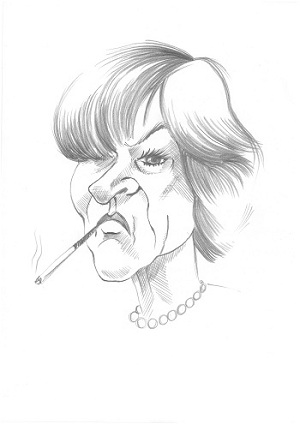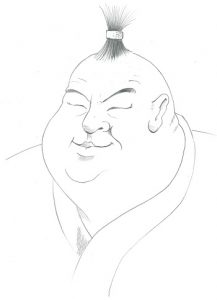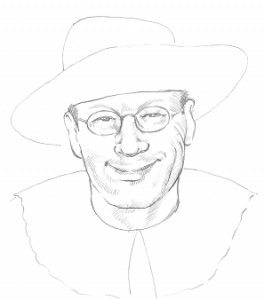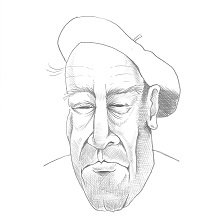Early Years
Case Studies: Fox Boy and “Tail Envy”
The Selfish Stage
“Shrink To The Stars”
The Inner Victim
Hoyt’s Legacy
Dr. Claire Hoyt, once the world-famous “Shrink to the Stars,” died in her Burbank, California home last Friday at the age of 79. Dr. Hoyt is generally credited with conceiving the “Inner Victim,” triggering the rise of the Victim Mentality in late twentieth century American society.
Dr. Hoyt, whose patients included two generations of Hollywood stars spanning from Rock Hudson to David Hasselhof, began her career as a confirmed Freudian theoretician. She later built a client-base consisting primarily of Hollywood actors, many of whom praised her even after she became a notorious leak to the tabloids, describing in detail the confidential secrets of her famous clients.
Early Years
Ms. Hoyt, born in Boston in 1920, claimed in her Autobiography (1985) that she was first drawn to psychoanalysis after meeting Freud himself during a family vacation to Austria in early 1938, just before Hitler’s annexation of Austria. (Freud himself was soon captured by the Gestapo, and when forced to inform the international press he had been well-treated wrote: “I can heartily recommend the Gestapo to anyone.”) According to Hoyt’s Autobiography, Claire saw Freud himself purchasing some cigars from a tobacconist in Vienna. She expressed her admiration to the great man, and her own desire to study psychoanalysis. Freud reputedly replied: “Young lady, you have the eye of a psychoanalyst. If you persist, and there is no limit to what you can accomplish.” She told the story of this meeting throughout her adult life, often holding the story in reserve for the times when her more outspoken patients expressed doubts about her effectiveness as a therapist.
Although her parents imbued Claire with an unshakable belief in her intellectual powers, her social graces remained undeveloped. Edgar Vinson, author of the definitive Hoyt biography, Stains on the Analyst’s Couch: The Life of Claire Hoyt, uncovered no intimate friends in her entire adult life—only professional allies who clung to the comet tail of her rising fame. In many ways, the people closest to Claire were her patients, a relationship in which she held all the cards.
Hoyt was accepted into Radcliffe College in 1940, and majored in psychology. During her doctoral courses, Hoyt underwent the required analysis by her mentor. While in her own self-evaluation Hoyt described herself as “giving, loving, strong, trustworthy,” her aged mentor, Professor Liedemann, described her “as an absolutely selfish monster. If she ever became armed with the authority of an analyst she would utterly victimize her patients with the intensity of her own bottomless insecurities, messianic complexes, and intractable neuroses.” Unfortunately Professor Liedemann died mysteriously during Hoyt’s analysis, and most of Liedemann’s notes vanished after his death. His replacement, the scrofulous Dr. Trachtenberg (later banned from the American Psychological Association for his relations with a fourteen year old female nymphomania patient) waved Hoyt through toward her doctorate with little resistance.
The Selfish Stage
Despite Liedemann’s reservations about her stability, her doctoral dissertation, “Self-Help in an Age of Society” was generally recognized to be of high quality, and it earned her a professorship in psychology at UCLA. From her new Los Angeles base, Hoyt began her first major psychological studies, which were to raise firestorms of controversy even in the East Coast intellectual catchment areas.
Her first seminal work, to which she gave the Whitman-esque title “Analysis of My Self,” posited a nebulous “selfish” stage in human development, potentially much more persisting than Freud’s stages, indeed perhaps lasting even until death. The selfish stage—certainly not a sinister development according in Hoytian psychology—is characterized by “marked preoccupation with the needs and concerns of the self, especially in regards to personal advancement, sexual fulfillment, the belief in one’s own intellectual equality or superiority vis a vis others.” Though other psychologists found this formulation spurious (“when are we not concerned with matters of the self?” asked an incredulous Carl Rogers), the new, psychologically-sanctioned Self-movement spread by word of mouth, even outside of academia into the California hinterland and Hollywood.
Case Studies: Fox Boy and “Tail Envy”
Under the aegis of the UCLA Department of Psychology, Hoyt embarked upon a brief but fruitful period of research. In an attempt to apply B.F. Skinner’s theory of learned helplessness to human sexuality, Hoyt selected 25 California healthy, sexually active men from ages of 25 to 49, and showed them pictures of the actress Vera Swanson eight hours a day for two weeks. It was later found that these men were incapable of achieving an erection, even five years after the study. Hoyt built upon these early studies, later concluding with B.F. Skinner that a “learned helplessness” characterized the mammalian kingdom—”especially the males.” Such findings made her a darling of the burgeoning feminist movement.
She also wrote extensive case studies about her patients, some of whom became famous. A “Louise” came to Dr. Hoyt, because of her chronic inability to achieve orgasm, whether through self-manipulation or during coitus with her husband. After eight months of sessions, Dr. Hoyt diagnosed her with “suspended hysteria,” brought about by her living through “an abnormally short selfish stage between her anal and oral stages.” She had never learned to mentally focus on her clitoral erogenous zone, and so, without treatment, was “forever doomed to a pathetic life devoid of sexual satisfaction.” Coincidentally, a nurse friend of “Louise” read the story in the Journal of the American Psychological Association, and told the real Louise about the article in passing. Louise recognized herself as the subject of the study, and later told Hoyt’s biographers she was shocked to read herself described in the article as “obviously untreatable,” especially as Hoyt had badgered her to continue her therapy for seven years at great expense.
Yet many patients found the combination of her affected Bostonian accent and facility with Freudian terminology a spell-binding combination. Some patients later told Hoyt’s biographer that she had claimed to be related to the Kennedys, which was manifestly untrue. And no matter how troubled the patient, his or her first session consisted of listening to Hoyt’s fifty minute monologue about her long and growing list of credentials, articles, and professional commendations however trifling–and sometimes her Freud story. Hoyt’s sessions were erratic, sometimes characterized by the analyst’s own garrulousness about her own personal problems. Other times she adopted a Trappist silence. Hoyt enforced the 50 minute hour mercilessly, famously sending away one wailing patient, the actress Natalie Brughetti, who had finally achieved “breakthrough” about the death of her father during her childhood.
Another of her famous studies concerned the “Fox Boy,” who suffered from recurring nightmares that he was a fox eating live chickens straight out of the chicken coop. He could no longer abide eating chicken or eggs, and suffered from the daytime hallucination that he had a big, bushy tail. Hoyt noted how the boy would lovingly stroke the tail of her cat, Gertrude, during sessions, and from this conceived her celebrated theory of “tail envy.”
“Much as amputees experience a strange sensation in the field of their missing limb,” wrote Hoyt, “so children feel the absence of their tails, lost in the mist of time to the process of evolution.” Hoyt even posited the shocking assertion that Freud was mistaken about girls’ experiencing penis envy, and argued that they experience “tail envy” of animals instead. But she never was unable to cure the hapless “Fox Boy,” who endured a disturbed adulthood.
“Shrink To The Stars”
Although her published case studies had earned a degree of respect among professional psychologists, by the mid 1950s Hoyt’s clientele consisted of affluent players within the motion picture industry. At about the same time she ceased writing for scholarly publications, but began her weekly column “Clear as Claire,” eventually syndicated nationally. Some found the use of the word “clear” to be a cryptic reference to L. Ron Hubbard’s Scientologists, who describe those complete the Scientology program as “clears,” but a positive link between Scientology and Hoyt has never been established.
Yet “seeing” Dr. Hoyt remained a status symbol for the stars, despite Hoyt’s notoriously loose lips. According to the Vinson biography, Jane Fonda recalled eating at Staunton’s, then a fashionable Hollywood restaurant, and hearing Dr. Hoyt expounding loudly about Rock Hudson’s secret homosexuality to her table of ten during the soup course. Hoyt, to whom Hudson had entrusted with his secret, performed a biting mimicry of his desperate pleas to remain undiscovered, reducing her table to hysteria, according to Fonda. On another occasion Ms. Hoyt disclosed confidential information about Judy Garland’s drug-abuse, calling it “weak” of the actress to take drugs for “emotional problems that most teen-agers successfully master.” A few actors stars were appalled by Hoyt’s gossiping as a flagrant violation of her profession, and terminated their visits.
Some actors used Hoyt as a reliable “leak” to the Hollywood tabloids, knowing that if they “confessed” to Dr. Hoyt a vicious libel about a rival, then it was certain to appear in publications such as The Hollywood Rag. The actress Elizabeth Clifton confessed to Hoyt her plans to divorce her third husband, who learned she was divorcing him only after reading about it in Reel To Real magazine. Actor John Masters successfully exposed his wife’s infidelities for divorce purposes by “confessing” to Hoyt the pain she caused him . The news was soon in the tabloids. Masters only had to pay a token alimony, and he later gleefully described his gambit in Chapter 7 of his Memoirs, “How I Spent the Money.”
Dr. Hoyt’s fame subsided in the late 1970s, but was refueled by the publication of her Autobiography in 1985, in which she remorselessly described the psychic frailties of her famous patients. David Hasselhof, for example, had a “Fuhrer Complex,” and cried out “But I am the greatest star in the world!” whenever Hoyt pointed out the “little boy within.” Hoyt’s Autobiography dished out so much dirt about powerful Hollywood stars (always through pseudonyms, but it was so easy to decode her ) that a backlash was inevitable.
Thus, Edgar Vinson discovered unusually co-operative subjects while performing celebrity interviews for his biography Stains on the Analyst’s Couch: The Life of Claire Hoyt (1991). Some of the stars seemed so driven by their vendettas against Hoyt that they were willing to incur damage to their own reputations–by stating why they were in therapy– in order to uncover the depths of Hoyt’s monstrosity. Liza Minelli, after admitting that Hoyt had diagnosed her with “bottomless narcissism,” reported that she received a vehement “You’re in denial!” whenever she challenged Hoyt’s theory of tail envy, which Hoyt regarded as axiomatic and refused even to discuss. Cher also reported Hoyt accusing her of denial after Cher expressed her skepticism that all women since Eve suffered from a “Madonna/Whore” complex. Cher believed herself immune from any Madonna impulses, but asked whether the Madonna/Whore formulation wasn’t “just some tight-ass way of saying it’s hard to be good.” Cher admitted that she only went to Hoyt because it was a status symbol in Hollywood to be analyzed by Hoyt during the peak of Hoyt’s reputation in the early 1970s.
Many patients Vinson interviewed described the difficulties they encountered ending their therapy. First, Hoyt would raise her eyebrows archly, “as if this [the desire to end therapy] were a new symptom,” or “a new sign of resistance”. Typically, Hoyt would counter by asking the patient how they “felt” about “the idea” of ending their treatment, and would accept only one word “feeling-word” answers to this query. Often these answers would prove unsatisfactory to Hoyt, who would then often recall the patient’s deepest wounds, and reduce them to tears by way of diversion. Patients with more sensitive souls often found it impossible to extricate themselves from Hoyt’s care, as interminable sessions were devoted to how they “felt” about terminating their treatment. Hoyt would exploit these sessions to explore the most unholy recesses of the patient’s psyche, yanking the scab off the oldest wounds, necessitating countless additional visits for many patients.
And yet for the most docile patients, Hoyt assumed an odd laissez-faire policy, as if they were only paying top dollar to speak to a disembodied ear. Shirley MacLaine reported sessions when Hoyt seemed oblivious to what she was confessing, yet would “nod her head in agreement, rhythmically, like those plastic birds you see in birdbaths, that continually draw water, lift their heads as the water runs out, and then dip again.” MacLaine even tested Hoyt’s interest by spending entire sessions contradicting herself, only to encounter the same metrynomic nodding and vapid look of acceptance.
The Inner Victim
Aside from her impact on celebrities, Hoyt’s influence will live on through her books. The Inner Victim (1978) represented the finale of Hoyt’s serious psychological work, but was also her most influential book. After The Inner Victim many people who had never thought of themselves as victims before realized that they had always been unwittingly oppressed by society and their parents. Consider
We live our lives with the vague sense we have been wronged. Deep down we know we are good and worthy of satisfying lives. We know that we belong. Yet we do not give voice to these thoughts. We know that we have been victimized, perhaps have always been. Yet it is this voice, the voice of the Inner Victim, that will always lead back to your true self.
Hoyt had been treating movie stars exclusively for twenty years, and, perhaps unconsciously, many of conclusions she reached after years of dealing with pampered stars, were now sold to the public at large as if they were definitive assessments of all of human nature.
Building on her work in The Inner Victim, Hoyt developed her theory to encompass all forms of human personality. For Hoyt, the fundamental dichotomy in human nature was the “aggressor/victim” (A/V) dichotomy. For Hoyt, aggression took many subtle forms including “strong extroversion, insisting upon the last word,” and even taking the last piece of chicken at a barbecue. Victims tend to be passive and weak, but Hoyt insisted that their heightened sensitivity suggested an “artist in larvae,” so that her clients tended to be flattered when Hoyt diagnosed them with a “victim’s mentality” that “revealed the butterfly within.”
The second key to personality for Hoyt was the inner-directed versus outer-directed predispositions. Aggressors could be either. Aggressive, inner-directed people (AIs) tended to destroy themselves primarily and others secondarily. In this class Hoyt placed alcoholics, regardless of the harm they heaped upon others. Aggressive, outer-directed persons (AO)s, tended to healthy self-esteems, and were content to control others without abusing them. But Hoyt’s clients tended to be victim/inner-directed persons (VIPs), often blameless lambs compared to the monsters who had raised or married them.
She encouraged group therapy, trying to cram as many $200 per hour patients into one room as possible. She even grouped them according to personality type, so that all “inner victim” met together, enduring group sessions of profound silences. The “outer victim” sessions featured heated exchanges, occasionally culminating in violent rows that Hoyt didn’t lift a finger to prevent. It was her habit to remain silent as a stone during group sessions, leaving both “inner” and “outer” victims’ to their fate.
Hoyt’s Legacy
Claire Hoyt is gone, but not forgotten. She has left behind a legacy of psychological work, and some would argue an equally vast legacy of psychological wounds. But she as much as anyone facilitated the spread of psychological jargon. The twentieth century should be called the “Age of Psychology,” in that psychological terms widely displaced religious and philosophical explanations of human behavior. Regardless of the quality of her theories, Hoyt helped psychology conquer America. Terms such as “Selfish Stage,” “Tail Envy,” and “Inner Victim” have entered the language as indispensable concepts to our self-understanding.
###










Be First to Comment